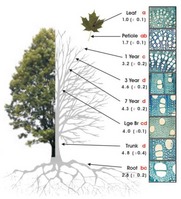 "Turning over a new leaf – hydraulics, light and leaf design"
"Turning over a new leaf – hydraulics, light and leaf design" "Turning over a new leaf – hydraulics, light and leaf design"
"Turning over a new leaf – hydraulics, light and leaf design"
Thursday, September 2
4:00 CNS 112
Seminar Series
Refreshments served at 3:40, 1st floor CNS foyer. Bring your mug.
Reduce, Reuse, Recycle.
Individuals with disabilities requiring accommodations should contact Nancy Pierce at 274-3161. We ask that requests for accommodations be made as soon as possible.
Image source: Choat, B., Lahr, E., Melcher P.J., et al Plant Cell and Environment 2005
Abstract:
Living things rely on the photosynthetic ability of leaves to use solar energy to convert water and carbon dioxide gas to energy rich sugar molecules as the basis for all food. Because light powers this sugar making process, and leaves lose water while absorbing carbon dioxide; leaf photosynthetic performance is directly related to leaf water status and light availability. It is well known that the photosynthetic capacity of leaves is highly dependent on leaf physiology, anatomy and morphology traits. For example, large thin leaves are generally well adapted to understory shaded environments and small thick leaves are well suited for bright light conditions. Because both water availability and light levels are highly varied within individual crowns of trees, it would be expected to find a high degree of intracanopy leaf plasticity. I will discuss results from several of my recent studies on intracanopy leaf plasticity measured on several tree species growing at one location, as well as from trees growing across large latitudinal gradients (e.g., Florida to Nova Scotia). It is believed that these data will provide new insights as to the adaptable potential of trees in response to climate change.
https://www.ithaca.edu/intercom/article.php/20100824095928135